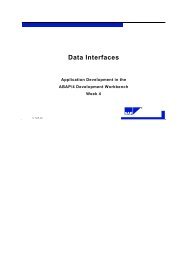business continuity institute good practice guidelines 2007
business continuity institute good practice guidelines 2007
business continuity institute good practice guidelines 2007
You also want an ePaper? Increase the reach of your titles
YUMPU automatically turns print PDFs into web optimized ePapers that Google loves.
Page 11<br />
Business Continuity Management GOOD PRACTICE GUIDELINES <strong>2007</strong><br />
• Combinations of the above methods can provide excellent results providing an<br />
appropriate level of detail and a standard reporting format that will assist in consistency<br />
of recording and analysing information across multiple functions.<br />
Data Collection Questionnaires<br />
There is no ‘one size fits all’ methodology for <strong>business</strong> impact analysis data collection. Methods<br />
vary from one industry sector to another and from one practitioner to another. Each industry<br />
has its own specific needs in result content, information types, depth and coverage. However a<br />
few basic principles that should be considered are:<br />
• The objective of the BIA is to collect information to educate the choice of appropriate<br />
<strong>continuity</strong> strategies which is determined by the urgency with which each activity needs<br />
to be resumed<br />
• How will the information collected be used?<br />
• What is the best format of data collection to report results effectively?<br />
• What basic information is needed to establish the urgency of the performance of the<br />
activity being analysed in isolation and as part of the organisation as a whole:<br />
♦ Timeframes within which the activity must be resumed<br />
♦ Locations from which activity is undertaken<br />
♦ Influences on the activity, e.g. peak periods, regulatory reporting<br />
♦ What is the impact of not continuing the activity<br />
♦ How long can the organisation last without it<br />
♦ Are there any alternatives?<br />
• Factors to consider include:<br />
♦ Volumes, e.g. calls per hour, output on production line<br />
♦ Contractual, regulatory or legal requirements<br />
♦ Key tools to achieving <strong>continuity</strong> of the activity (how many, where and when):<br />
♦ People – skill set<br />
♦ Equipment – IT, telecommunications, manufacturing / industrial plant<br />
♦ Data – paper and electronic<br />
♦ Dependencies – internal and external to organisation<br />
Software<br />
There are a variety of proprietary software products available to conduct Business Impact<br />
Analyses that may be useful but are not essential. The key benefits of utilising a software tool<br />
include ease of analysing results, storage of information and potentially reporting of the results<br />
their use does not however remove the need for interviews with or involvement of individuals<br />
knowledgeable in the activity being analysed.<br />
Reporting<br />
Every organisation has its own preferred style of reporting and in some instances the reporting<br />
style may need to be adjusted to accommodate multiple audience groups within the one<br />
Version <strong>2007</strong>.2 15th March <strong>2007</strong> © The Business Continuity Institute <strong>2007</strong>
















